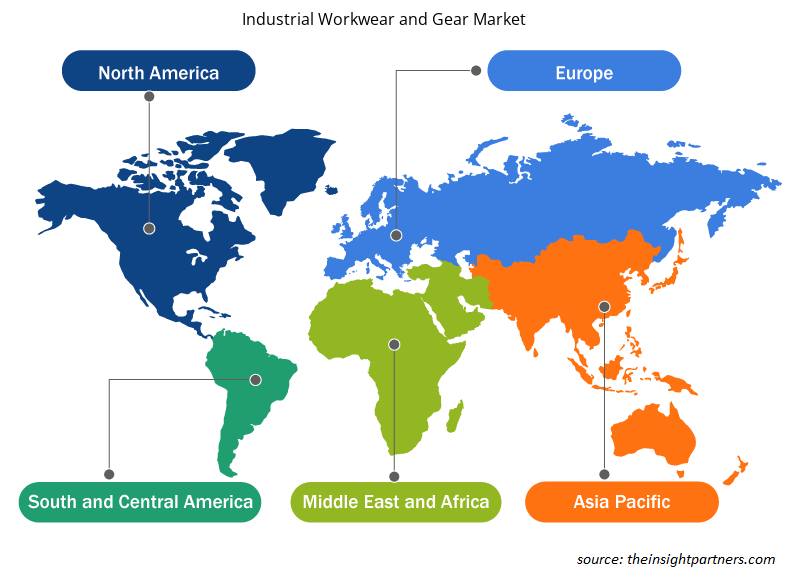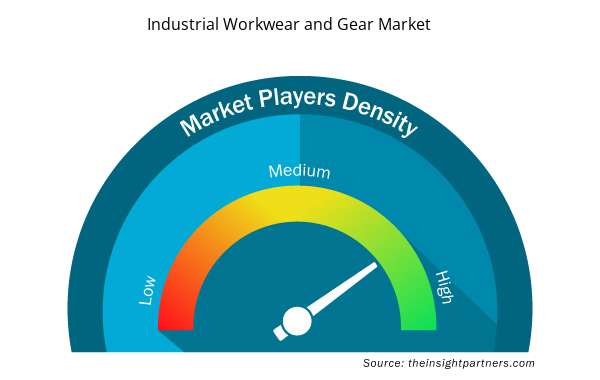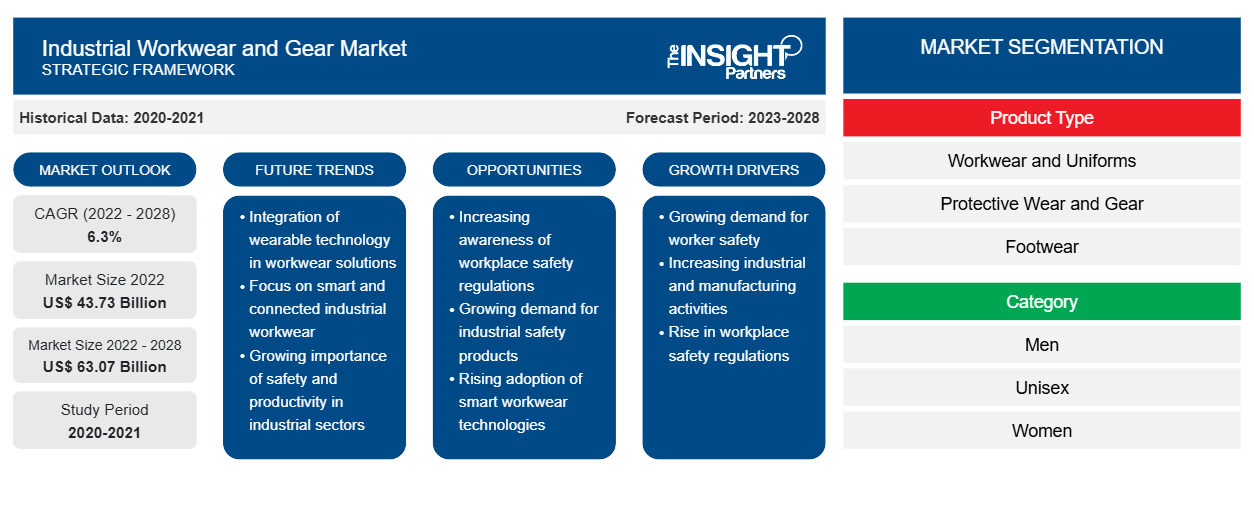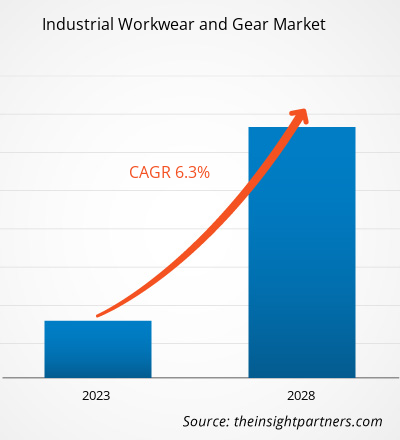Se proyecta que el tamaño del mercado de ropa y equipos de trabajo industriales crecerá de US$ 43.725,45 millones en 2022 a US$ 63.072,02 millones en 2028; se espera que el mercado registre una CAGR del 6,3% entre 2022 y 2028.
Los productos de ropa de trabajo industrial ayudan a garantizar la seguridad de los trabajadores en entornos industriales. Están diseñados específicamente para absorber golpes o cualquier tipo de impacto que pueda causar lesiones a los empleados y trabajadores. Además, están hechos de materiales resistentes al desgaste, a los productos químicos y a las llamas que ofrecen una protección eficaz contra diferentes peligros. Los fabricantes de ropa de trabajo industrial están lanzando productos rentables con características avanzadas para satisfacer la creciente demanda de los consumidores, lo que se espera que brinde inmensas oportunidades para el crecimiento del mercado de ropa y equipos de trabajo industriales en los próximos años.
Impacto de la pandemia de COVID-19 en el mercado de ropa y equipamiento para el trabajo industrial
En 2020, varias industrias tuvieron que reducir su actividad debido a las interrupciones en las cadenas de valor y suministro causadas por el cierre de fronteras nacionales e internacionales. La pandemia de COVID-19 afectó negativamente a las economías y las industrias debido a los confinamientos, las prohibiciones de viaje y los cierres de empresas. Las restricciones impuestas por las autoridades gubernamentales provocaron interrupciones en las cadenas de suministro de materias primas clave e irregularidades en los procesos de fabricación, lo que afectó directamente a las industrias manufactureras, obstaculizando así la producción y la demanda de ropa de trabajo industrial. Sin embargo, la pandemia de COVID-19 también tuvo un impacto favorable en el mercado de ropa y equipamiento de trabajo industrial hasta cierto punto. La demanda de equipos de protección individual (EPI) aumentó en los laboratorios de investigación, lo que contribuyó al desarrollo de vacunas para diferentes variantes del SARS-CoV-2, para evitar la exposición directa de los empleados al virus. Con un aumento abrupto de la demanda, los fabricantes de EPI aumentaron sus capacidades de producción.
Personalice este informe según sus necesidades
Obtendrá personalización en cualquier informe, sin cargo, incluidas partes de este informe o análisis a nivel de país, paquete de datos de Excel, así como también grandes ofertas y descuentos para empresas emergentes y universidades.
- Obtenga las principales tendencias clave del mercado de este informe.Esta muestra GRATUITA incluirá análisis de datos, desde tendencias del mercado hasta estimaciones y pronósticos.
Perspectivas del mercado
La creciente demanda de las economías emergentes impulsará el crecimiento del mercado en los próximos años
Los gobiernos de las economías emergentes están aumentando su enfoque en el desarrollo de infraestructura. Por ejemplo, en noviembre de 2021, India, Estados Unidos, Israel y los Emiratos Árabes Unidos establecieron un nuevo foro económico cuadrilateral para centrarse en proyectos de desarrollo de infraestructura y reforzar la cooperación bilateral. Es probable que estas iniciativas gubernamentales impulsen la demanda de ropa y equipo de trabajo industrial en las economías emergentes. Además, el número de proyectos de infraestructura, como el Proyecto de Desarrollo del Complejo de Olefinas de Tuban (Indonesia), el Sistema de Alcantarillado del Túnel Profundo de Singapur y el Enlace Shenzhong (China), está aumentando en los países en desarrollo, lo que se espera que impulse la demanda de ropa y equipo de trabajo industrial para garantizar la seguridad de los trabajadores. Por lo tanto, se anticipa que los rápidos desarrollos en los sectores industriales en las economías emergentes crearán oportunidades lucrativas para el mercado de ropa y equipo de trabajo industrial durante el período de pronóstico.
Información basada en el tipo de producto
Según el tipo, el mercado de ropa y equipamiento industrial se segmenta en ropa y uniformes de trabajo, ropa y equipamiento de protección, calzado, guantes y otros. Se prevé que el segmento de ropa y equipamiento de protección registre la CAGR más alta durante el período de pronóstico. La Organización Internacional del Trabajo lleva a cabo un código de prácticas para la seguridad y salud ocupacional de los empleados en todo el mundo. Las industrias de minería de carbón, fabricación de productos químicos y generación de energía, entre otras, siguen las regulaciones establecidas por dichos organismos reguladores. El mandato de cumplimiento de las regulaciones con respecto a la protección de los empleados impulsa la demanda de ropa y equipamiento de protección.
Perspectivas basadas en la industria de uso final
Según la industria de uso final, el mercado de ropa y equipos de trabajo industriales se segmenta en construcción, petróleo y gas, productos químicos, industrias pesadas y manufactura, minería, productos farmacéuticos y otros. El segmento de industrias pesadas y manufactura tuvo la mayor participación del mercado en 2021. La industria manufacturera incluye empresas que producen pulpa y papel, maquinaria y equipo, productos poliméricos, productos minerales no metálicos, muebles, caucho y productos de madera. La exposición continua de los trabajadores a entornos peligrosos y la falta de disponibilidad de calzado de protección para los trabajadores han sido la principal causa de accidentes industriales en el sector manufacturero durante años. Los monos, guantes y mangas de protección, gorras/sombreros, abrigos, chaquetas, camisas, calcetines, chaquetas softshell, sudaderas, pantalones, mascarillas, protectores faciales, chalecos y botas y zapatos de protección con puntera están diseñados específicamente para proteger las partes superiores e inferiores del cuerpo de los trabajadores de los sectores de la industria pesada y la manufactura.
Entre los actores clave que operan en el mercado de ropa y equipamiento para el trabajo industrial se encuentran Carhartt, Inc.; ARAMARK; Alsico Group; A. LAFONT SAS; Honeywell International Inc.; Hultafors Group AB; Lakeland Industries Inc.; VF Corporation; Ansell Ltd.; Hultafors Group AB; y Mustang Workwear. Estos actores se centran en proporcionar productos de alta calidad para satisfacer las demandas de los clientes. También se centran en estrategias como inversiones en actividades de investigación y desarrollo y lanzamientos de nuevos productos.
Perspectivas regionales del mercado de ropa y equipamiento para el trabajo industrial
Los analistas de Insight Partners explicaron en detalle las tendencias y los factores regionales que influyen en el mercado de ropa y equipamiento para el trabajo industrial durante el período de pronóstico. Esta sección también analiza los segmentos y la geografía del mercado de ropa y equipamiento para el trabajo industrial en América del Norte, Europa, Asia Pacífico, Oriente Medio y África, y América del Sur y Central.

- Obtenga datos regionales específicos para el mercado de ropa y equipamiento de trabajo industrial
Alcance del informe de mercado de ropa y equipamiento para el trabajo industrial
| Atributo del informe | Detalles |
|---|---|
| Tamaño del mercado en 2022 | US$ 43,73 mil millones |
| Tamaño del mercado en 2028 | US$ 63.07 mil millones |
| CAGR global (2022-2028) | 6,3% |
| Datos históricos | 2020-2021 |
| Período de pronóstico | 2023-2028 |
| Segmentos cubiertos | Por tipo de producto
|
| Regiones y países cubiertos | América del norte
|
| Líderes del mercado y perfiles de empresas clave |
|
Densidad de actores del mercado de ropa y equipamiento para el trabajo industrial: comprensión de su impacto en la dinámica empresarial
El mercado de ropa y equipamiento para el trabajo industrial está creciendo rápidamente, impulsado por la creciente demanda de los usuarios finales debido a factores como la evolución de las preferencias de los consumidores, los avances tecnológicos y una mayor conciencia de los beneficios del producto. A medida que aumenta la demanda, las empresas amplían sus ofertas, innovan para satisfacer las necesidades de los consumidores y aprovechan las tendencias emergentes, lo que impulsa aún más el crecimiento del mercado.
La densidad de actores del mercado se refiere a la distribución de las empresas o firmas que operan dentro de un mercado o industria en particular. Indica cuántos competidores (actores del mercado) están presentes en un espacio de mercado determinado en relación con su tamaño o valor total de mercado.
Las principales empresas que operan en el mercado de ropa y equipamiento de trabajo industrial son:
- WATTANA GmbH
- Compañía Carson GmbH
- HB Protective Wear GmbH & Co. KG
- Engelbert Strauss GmbH und Co. KG
- 3M
Descargo de responsabilidad : Las empresas enumeradas anteriormente no están clasificadas en ningún orden particular.

- Obtenga una descripción general de los principales actores clave del mercado de ropa y equipo de trabajo industrial
Informe Destacado
- Tendencias progresivas de la industria en el mercado de ropa y equipos de trabajo industriales para ayudar a los actores a desarrollar estrategias efectivas a largo plazo
- Estrategias de crecimiento empresarial adoptadas por las empresas para asegurar el crecimiento en los mercados desarrollados y en desarrollo
- Análisis cuantitativo del mercado de ropa y equipamientos de trabajo industriales de 2022 a 2028
- Estimación de la demanda mundial de ropa y equipos de trabajo industriales
- Análisis de las cinco fuerzas de Porter para ilustrar la eficacia de los compradores y proveedores de ropa y equipos de trabajo industriales
- Avances recientes para comprender el escenario competitivo del mercado
- Tendencia y perspectivas del mercado, junto con los factores que impulsan y restringen el crecimiento del mercado de ropa y equipos de trabajo industriales
- Asistencia en el proceso de toma de decisiones destacando las estrategias de mercado que sustentan el interés comercial.
- El tamaño del mercado de ropa y equipamiento de trabajo industrial en varios nodos
- Descripción detallada y segmentación del mercado, así como la dinámica de la industria de ropa y equipos de trabajo industriales.
- Tamaño del mercado de ropa y equipos de trabajo industriales en varias regiones con prometedoras oportunidades de crecimiento
Perfiles de empresas
- Tienda de campaña Carhartt, Inc.
- ARAMARCA
- Grupo Alsico
- A. LAFONT SAS
- Compañía: Honeywell International Inc.
- Grupo Hultafors AB
- Industrias Lakeland Inc.
- Corporación VF; Ansell Ltd.
- Grupo Hultafors AB
- Ropa de trabajo Mustang
- Análisis histórico (2 años), año base, pronóstico (7 años) con CAGR
- Análisis PEST y FODA
- Tamaño del mercado Valor/volumen: global, regional, nacional
- Industria y panorama competitivo
- Conjunto de datos de Excel



Report Coverage
Revenue forecast, Company Analysis, Industry landscape, Growth factors, and Trends

Segment Covered
This text is related
to segments covered.

Regional Scope
North America, Europe, Asia Pacific, Middle East & Africa, South & Central America

Country Scope
This text is related
to country scope.
Preguntas frecuentes
An increase in industrial accidents and work-related mortality and introducing a stringent regulatory framework for the industrial sector are some of the key driving factors for the industrial workwear and gear market.
Based on category, unisex is the fastest-growing segment in the industrial workwear and gear market due to the increasing implementation of gender-neutral dress codes at workplaces.
Europe accounted for the largest share of the global industrial workwear and gear market. The increasing number of construction sites in Europe and the uncertainty associated with the pandemic have resulted in an urge for effective protective workwear.
Based on the product type, the workwear and uniforms segment accounted for the largest revenue share as the internal policies at various industrial workplace allow employers to set dress codes for employees which drives the growth of the segment.
The increasing development in various industrial sectors of emerging economies has propelled the need to maintain the safety of workers while working. Thus, rapid development in industrial sectors of emerging economies is anticipated to create lucrative opportunities for the industrial workwear and gear market during the forecast period.
The major players operating in the global industrial workwear and gear market are Carhartt, Inc.; ARAMARK; Alsico Group; A. LAFONT SAS; Honeywell International Inc.; Hultafors Group AB; Lakeland Industries Inc.; VF Corporation; Ansell Ltd.; Hultafors Group AB; and Mustang Workwear among few others.
Trends and growth analysis reports related to Consumer Goods : READ MORE..
The List of Companies - Industrial Workwear and Gear Market
- WATTANA GmbH
- Carson Company GmbH
- HB Protective Wear GmbH & Co. KG
- Engelbert Strauss GmbH and Co. KG
- 3M
- Carhartt, Inc.
- Alsico Group
- A. LAFONT SAS
- Hultafors Group AB
- Honeywell International Inc.
The Insight Partners performs research in 4 major stages: Data Collection & Secondary Research, Primary Research, Data Analysis and Data Triangulation & Final Review.
- Data Collection and Secondary Research:
As a market research and consulting firm operating from a decade, we have published and advised several client across the globe. First step for any study will start with an assessment of currently available data and insights from existing reports. Further, historical and current market information is collected from Investor Presentations, Annual Reports, SEC Filings, etc., and other information related to company’s performance and market positioning are gathered from Paid Databases (Factiva, Hoovers, and Reuters) and various other publications available in public domain.
Several associations trade associates, technical forums, institutes, societies and organization are accessed to gain technical as well as market related insights through their publications such as research papers, blogs and press releases related to the studies are referred to get cues about the market. Further, white papers, journals, magazines, and other news articles published in last 3 years are scrutinized and analyzed to understand the current market trends.
- Primary Research:
The primarily interview analysis comprise of data obtained from industry participants interview and answers to survey questions gathered by in-house primary team.
For primary research, interviews are conducted with industry experts/CEOs/Marketing Managers/VPs/Subject Matter Experts from both demand and supply side to get a 360-degree view of the market. The primary team conducts several interviews based on the complexity of the markets to understand the various market trends and dynamics which makes research more credible and precise.
A typical research interview fulfils the following functions:
- Provides first-hand information on the market size, market trends, growth trends, competitive landscape, and outlook
- Validates and strengthens in-house secondary research findings
- Develops the analysis team’s expertise and market understanding
Primary research involves email interactions and telephone interviews for each market, category, segment, and sub-segment across geographies. The participants who typically take part in such a process include, but are not limited to:
- Industry participants: VPs, business development managers, market intelligence managers and national sales managers
- Outside experts: Valuation experts, research analysts and key opinion leaders specializing in the electronics and semiconductor industry.
Below is the breakup of our primary respondents by company, designation, and region:

Once we receive the confirmation from primary research sources or primary respondents, we finalize the base year market estimation and forecast the data as per the macroeconomic and microeconomic factors assessed during data collection.
- Data Analysis:
Once data is validated through both secondary as well as primary respondents, we finalize the market estimations by hypothesis formulation and factor analysis at regional and country level.
- Macro-Economic Factor Analysis:
We analyse macroeconomic indicators such the gross domestic product (GDP), increase in the demand for goods and services across industries, technological advancement, regional economic growth, governmental policies, the influence of COVID-19, PEST analysis, and other aspects. This analysis aids in setting benchmarks for various nations/regions and approximating market splits. Additionally, the general trend of the aforementioned components aid in determining the market's development possibilities.
- Country Level Data:
Various factors that are especially aligned to the country are taken into account to determine the market size for a certain area and country, including the presence of vendors, such as headquarters and offices, the country's GDP, demand patterns, and industry growth. To comprehend the market dynamics for the nation, a number of growth variables, inhibitors, application areas, and current market trends are researched. The aforementioned elements aid in determining the country's overall market's growth potential.
- Company Profile:
The “Table of Contents” is formulated by listing and analyzing more than 25 - 30 companies operating in the market ecosystem across geographies. However, we profile only 10 companies as a standard practice in our syndicate reports. These 10 companies comprise leading, emerging, and regional players. Nonetheless, our analysis is not restricted to the 10 listed companies, we also analyze other companies present in the market to develop a holistic view and understand the prevailing trends. The “Company Profiles” section in the report covers key facts, business description, products & services, financial information, SWOT analysis, and key developments. The financial information presented is extracted from the annual reports and official documents of the publicly listed companies. Upon collecting the information for the sections of respective companies, we verify them via various primary sources and then compile the data in respective company profiles. The company level information helps us in deriving the base number as well as in forecasting the market size.
- Developing Base Number:
Aggregation of sales statistics (2020-2022) and macro-economic factor, and other secondary and primary research insights are utilized to arrive at base number and related market shares for 2022. The data gaps are identified in this step and relevant market data is analyzed, collected from paid primary interviews or databases. On finalizing the base year market size, forecasts are developed on the basis of macro-economic, industry and market growth factors and company level analysis.
- Data Triangulation and Final Review:
The market findings and base year market size calculations are validated from supply as well as demand side. Demand side validations are based on macro-economic factor analysis and benchmarks for respective regions and countries. In case of supply side validations, revenues of major companies are estimated (in case not available) based on industry benchmark, approximate number of employees, product portfolio, and primary interviews revenues are gathered. Further revenue from target product/service segment is assessed to avoid overshooting of market statistics. In case of heavy deviations between supply and demand side values, all thes steps are repeated to achieve synchronization.
We follow an iterative model, wherein we share our research findings with Subject Matter Experts (SME’s) and Key Opinion Leaders (KOLs) until consensus view of the market is not formulated – this model negates any drastic deviation in the opinions of experts. Only validated and universally acceptable research findings are quoted in our reports.
We have important check points that we use to validate our research findings – which we call – data triangulation, where we validate the information, we generate from secondary sources with primary interviews and then we re-validate with our internal data bases and Subject matter experts. This comprehensive model enables us to deliver high quality, reliable data in shortest possible time.


 Obtenga una muestra gratuita de este informe
Obtenga una muestra gratuita de este informe